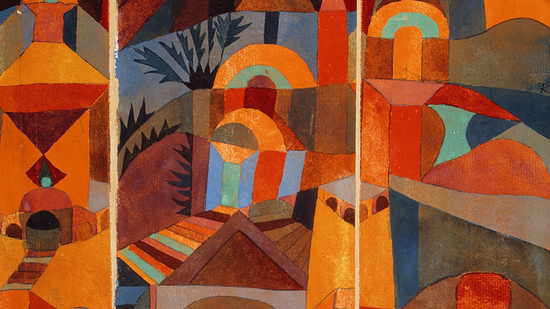
Who was Paul Klee?
the swiss artistPaul Klee, known for his paintings of simple figures of suspended fish, moon faces, eyes, arrows and colorful bedspreads, marked the history of art, due to his extensive production in the various innovative artistic movements of the 20th century. From German Expressionism through Dadaism to Abstractionism, this artist was part of the greatest movements that changed the course of modern art, as they radically broke the art tradition of the faithful representation of objects and the real world. His abstract compositions filled with symbols that embody spiritual content and the subconscious have influenced artists such as Joan Miró, Salvador Dalí The Mark Rothko and Robert Motherwell. Learn more in this article about one of the first artists to contribute to the present-day art form of Abstractionism.
In the Style of Kairouan, 1914

Paul Klee was born in 1879 in Switzerland, where he studied drawing and painting. In 1911, he became involved with the German Expressionist group Der Blaue Reiter (The Blue Rider), founded by Vasily Kandinsky and Franz Marc. We perceive the influence of this group, of the Cubism of Pablo Picasso and Georges Braque, and Robert Delaunay's abstract color planes in his works. In 1914, he visited Tunisia, a land that awakened his sense of color and showed him the path to abstraction. About this trip the artist stated: "Color has taken possession of me; no longer do I have to chase after it, I know that it has hold of me forever... Color and I are one. I am a painter." When he returned, he painted his first purely abstract work, In the Style of Kairouan (1914), composed of colored rectangles and some circles. The colored rectangle has become a building block that can be associated with a musical note, combined with other colored blocks that create a harmony of colors like a musical composition. Thus, the specific color selection of Paul Klee emulates a musical tonality.
Static-Dynamic Gradation, 1923

From 1915 he began to express the most diverse subjects drawn from his imagination with abstract shapes and happy symbols. The themes are diverse and reveal his humor and inclination towards the fantastic. Always concerned with the touch of words, titles played an important role in his works, by establishing the perspective from which Paul Klee he wanted the works to be seen, whether in an ironic, poetic, irreverent, expressionless or melancholic way.
Ventriloquist and Crier in the Moor, 1923

In 1920, he was invited by Walter Gropius to be a professor at the Bauhaus, a school of architecture and industrial design. Almost half of the approximately 10,000 jobs Paul Klee (mainly small-scale watercolors and drawings on paper) were produced during the ten years he taught at the Bauhaus. The themes are diverse from their concern with the relationship of colors, as seen in Static-Dynamic Gradation to your fantasies, in Ventriloquist and Crier in the Moor. From 1931 to 1933, he was a professor at the Academy of Fine Arts in Düsseldorf. When the National Socialists declared their art "degenerate" in 1933, Paul Klee returned to Switzerland. Personal difficulties and the growing gravity of the political situation in Europe are reflected in the somber tone of his works. The lines turn into black bars, the shapes have a larger scale and the colors are simple, as you can see in the painting. Comedians HandbillIt is Angel Applicant.
Angel Applicant, 1939

Paul Klee he always maintained an experimentalist posture but with a language of his own, with practically monochromatic or highly polychromatic canvases, geometric shapes, as well as letters, numbers, arrows, figures of animals and people in an abstract way. He is considered one of the main and most versatile modern artists of the 20th century, with a production that incorporated several movements: Expressionism, Cubism, Futurism, Surrealism and Atractionism.
Handbill Comedians, 1938

